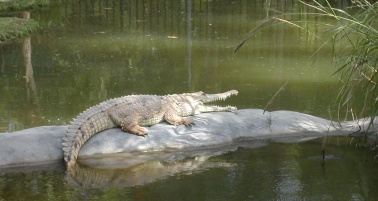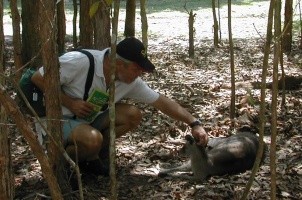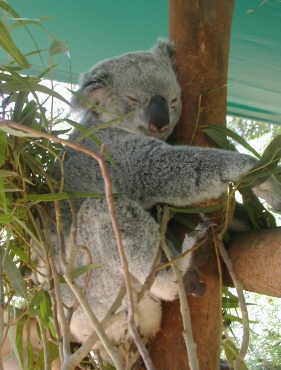AUSTRALIA ZOO

Freshwater crocodile
We don’t usually like zoos. We don’t like seeing wild animals confined. However, Nita really wanted to see the saltwater crocs, and we both prefer seeing them confined – or at least kept some distance away from us. So off to the zoo we went like the tourists we have become.
Our first stop was to see the crocs. They have about five ‘salties’ (salt water crocs) and probably more than a dozen ‘freshies’ (fresh water crocs). The salties are larger, more aggressive, and more dangerous than the freshies. We saw salties in and out of the water. They are eating machines that can leap their body length (up to 22 feet long) and move surprising fast. Freshies are also fast, but they are not nearly as aggressive as the salties.
We enjoyed their Asian elephant exhibit. Nita hand-fed some apple to an elephant, and she was thoroughly slimed with elephant snot. We watched them enjoy their pool. They seemed to like it a lot.
We petted countless kangaroos. We didn’t know that there were so many different roos, but we saw and petted them all. Like dogs, they seemed to particularly like their ears scratched. Also like dogs, they liked being hand-fed. The zoo sold bags of pellets that the roos could eat, and they clearly enjoyed being hand-fed – especially the little joeys.
We were watching a ‘show’ with Bengal tigers, and one turned on its trainer. Another trainer stepped in and quickly got things under control but not until the one trainer was slightly hurt and severely shaken up. Do these cats belong in ‘shows’?

Scratching his ears

Cute & cuddly koala
The koalas were charming. We pet one, and it was remarkably soft. We also watched one mom crawling around with a baby on her back. Very cute.
We walked through an aviary that had lots of colorful birds that neither of us had seen before. Some would allow us to come close, but we did not try to touch any of them.
We also saw wombat and cassowary. We went through the reptile house and saw some of the planet’s most deadly snakes and a non-venomous (but still dangerous) 18 foot python. And, of course, we saw a tasmanian devil.
What most impressed us about this zoo was the interactions between the animal handlers and the animals. The handlers treated the animals gently, and they appeared to care for the animals. We didn’t see any animals being treated badly. We left feeling good about the zoo and what they are doing there.
And what are they doing other than displaying animals? They provide a lot of information on wildlife preservation, and they are raising money for wildlife preservation in southeast Asia` The Bengal tiger is nearly extinct. Attempts are being made to breed them in captivity, and that seems their only hope to remain on the planet. So, in addition to being an entertaining place to spend a day, Australia Zoo has a mission that we respected.